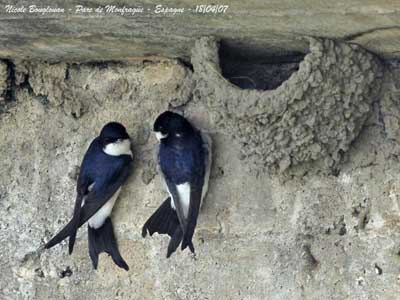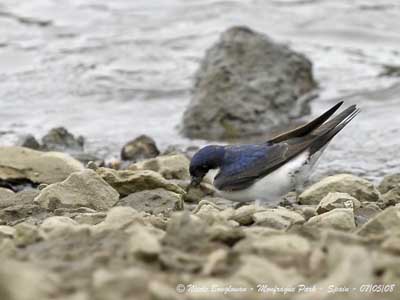
DIET:
The Common House Martin feeds almost exclusively on several insects’ species. It hunts in flight and can pursue flying insects on the wing, but it also hunts on the ground where it picks up insects.
PROTECTION / THREATS / STATUS:
The Common House Martin is common and widespread according to the range.
In spite of nest-site competition from House Sparrow, this species has benefited from human structure development, providing other nesting sites.
The populations of the Common House Martin are not currently threatened.
Fr: Hirondelle de fenêtre
All : Mehlschwalbe
Esp: Avión Común
Ital: Balestruccio
Nd: Huiszwaluw
Sd: Hussvala
Text and pictures by Nicole Bouglouan
Sources :
HANDBOOK OF THE BIRDS OF THE WORLD Vol 9 - by Josep del Hoyo - Andrew Elliot - David Christie - Lynx Edicions - ISBN: 8487334695
THE HANDBOOK OF BIRD IDENTIFICATION FOR EUROPE AND THE WESTERN PALEARCTIC by Mark Beaman, Steve Madge - C.Helm - ISBN: 0713639601
THE COMPLETE BOOK OF BRITISH BIRDS – Written by “Royal Society for the Protection of Birds” experts - Préface de Magnus Magnusson - Michael Cady- Rob Hume Editors - ISBN: 0749509112
L’ENCYCLOPEDIE MONDIALE DES OISEAUX - Dr Christopher M. Perrins - BORDAS - ISBN: 2040185607
ENCYCLOPEDIE DES OISEAUX DE FRANCE ET D’EUROPE – de Peter Hayman et Rob Hume - Flammarion – ISBN : 2082009920
What Bird-The ultimate Bird Guide (Mitchell Waite)
Wikipedia, the free encyclopaedia
XENO-CANTO – Sharing Birds sounds from around the world
Common House Martin
Delichon urbicum
Passeriforme Order – Hirundinidae Family
BIOMETRICS:
Length: 13-14 cm
Wingspan: 26-29 cm
Weight: 16-23 g
DESCRIPTION:
The Common House Martin is a pretty swallow often living close to humans. Numerous buildings shelter the nests of this migratory species.
The adult male in breeding plumage has glossy blue crown and back, sometimes with white bases on hindcrown feathers. The rump is white. The long wings and the forked tail are black.

The underparts are white, including chin, throat and head sides. Underwing and undertail are greyish.
The short bill is black. The eyes are blackish-brown. The legs are white and feathered. The feet are pink.
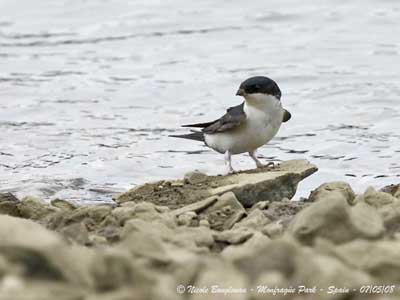
The adult male in non-breeding plumage has white mottled brown-grey rump, face sides, throat and flanks.
The adult female is almost similar to the male, but she has greyer underparts.
The juvenile is duller and browner, with less blue. It also has shorter tail.
We can find three subspecies:
D.u. urbicum occurs in W, C and N Europe to W Siberia. It winters in sub-Saharan Africa.
D.u. meridionale is found from S Europe, N Africa and WC Asia. It winters in Africa and SW Asia. This one is smaller than nominate.
D.u. lagopodum occurs from E Asia, N Mongolia and NE China. It winters mainly in SE Asia. This race has more white on lower back and less forked tail.
VOICE: SOUNDS BY XENO-CANTO
The Common House Martin utters a hard “prrt” or longer and plaintive “pri-pit” (similar to pebbles rubbed together) as contact call. The alarm call is a high-pitched “tsitsitsitsier” and some shorter variants “tsieer”. When threatened, it utters hissing distress calls.
The song is a soft, flute-like twittering, interspersed with dry rattles.
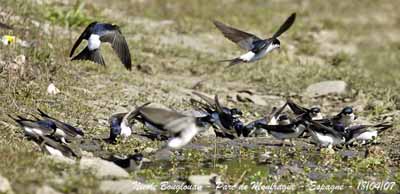
HABITAT:
The Common House Martin likes the open areas and frequents coastal cliffs, cultivated fields and human areas such as towns and cities. This species can live in mountainous areas up to 2000 metres of elevation in Europe, and up to 4500 metres in Asia.
RANGE:
The Common House Martin breeds in Europe, N Africa and temperate regions of Asia.
This species is migratory and spends the winter in Sub-Saharan Africa and tropical Asia. They migrate in flocks of several hundreds or thousands after the breeding period.
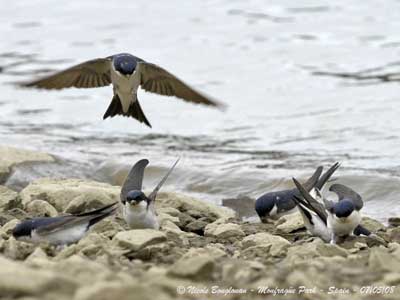
BEHAVIOUR:
The Common House Martin feeds almost exclusively on small insects such as Dipterans, Homopterans, Hymenopterans, and a few Coleopterans and some flying ants. But the diet varies according to the range. It can also take small Odonata, Lepidopterans and Orthopterans, and some spiders. It pursues the flying insects in the air and can fly for hours while hunting.
This bird forages in flocks, and even with other birds’ species. They hunt at some distance from the nest, up to 2 kilometres.
But the Common House Martin hunts also on the ground, picking up at insects, or perched on rocks or vegetation. It also follows the ploughs and catches insects flushed by large animals and cattle.
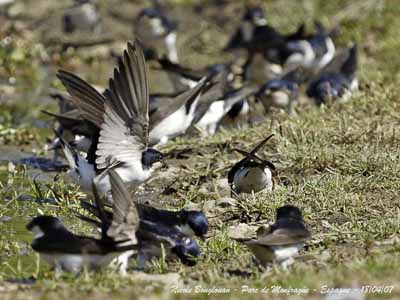
They roost in their nests or sometimes communally, also on cliffs or trees, but usually in sheltered sites.
They conserve the energy by clustering in order to survive for a day or so without food in very bad weather conditions. In extreme conditions, they can enter hypothermic torpor lowering their body temperature during the night.
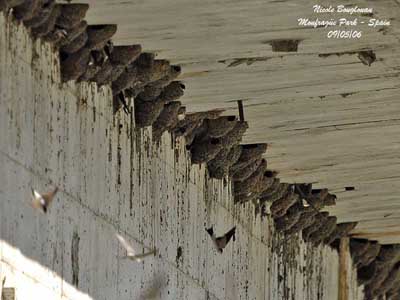
Usually, they return to the same nesting site, and the pairs can breed together for more than one year. The pair becomes aggressive and defends the nest-site. Threat displays are observed, involving ruffling of head feathers, vibrating wings and calling. They also chase the intruders and fights can occur.
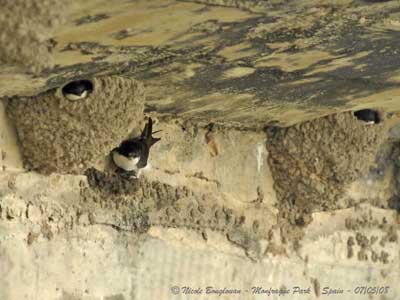
The fights between males can be violent. They beat each other with the wings, peck and hold with the bill, and grapple with the feet. They even can fall to the ground. These fights sometimes involve injury or death.
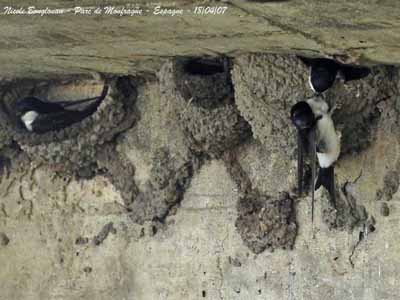
Copulation between mates occurs inside the nest, after a short invitation display. The male attracts the female by calling and following her. When she perches, it approaches and sings. Preening often follows the copulation.
Other males try to enter nests in order to copulate with the resident female. For this reason, the paired male performs “mate-guarding” until the clutch is laid. Then, it may attempt to copulate with other females.
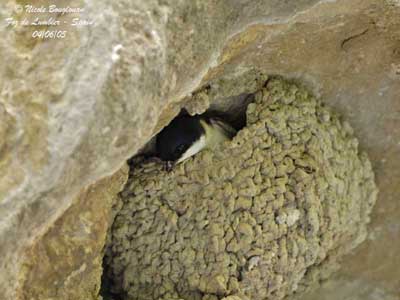
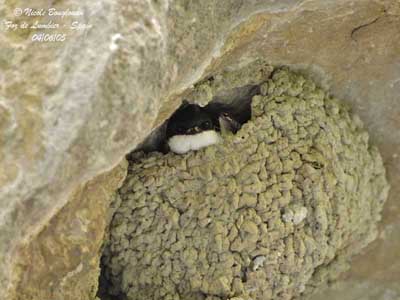
FLIGHT:
The Common House Martin soars for long periods. It is a good flier, able to dive, climb, glide, hover and spiral when chasing fast-flying insects. It flies swiftly with frequent turning and banking. It performs strong, rapid wing-beats.

REPRODUCTION:
The breeding season varies according to the range. This species can produces two broods per season.
The Common House Martin breeds in large colonies of hundreds of pairs, but also of less than ten pairs. They nest in cliffs, on the undersides of bridges, or below an overhanging rocky-ledge, and can use human structures. The nest is built at the junction of both vertical and overhanging surface. The nests are often clustered together with entrances about 8-10 centimetres apart. Each pair defends this short area around the nest entrance.
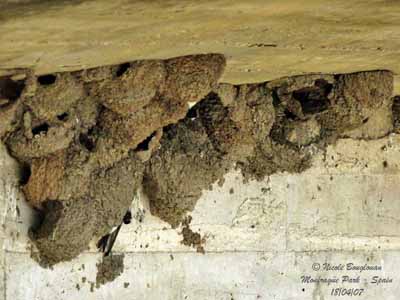
The nest is made with mud. The birds collect pellets of wet mud near water, from ponds and streams, and add them little by little, in successive layers, until to form a cup with a narrow top entrance. The interior is often lined with grass and soft materials.
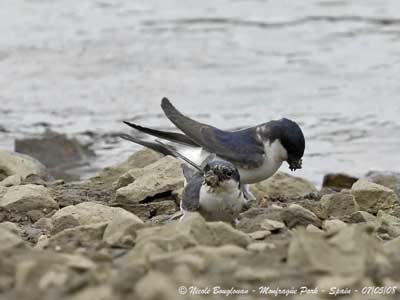
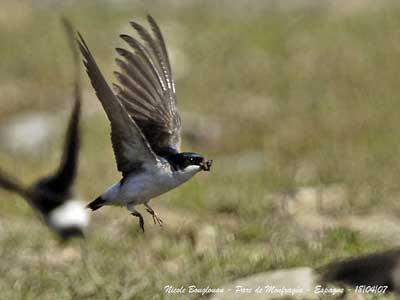
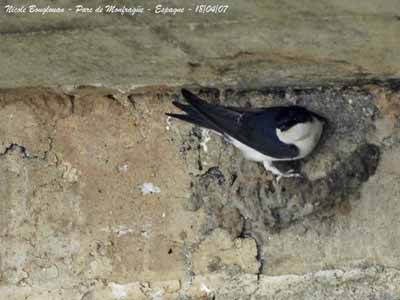
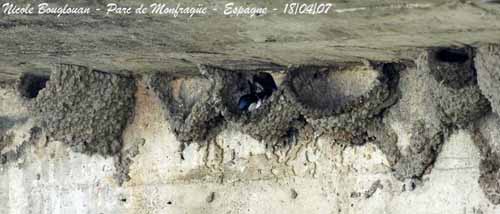
The female lays 1-7 eggs. Both sexes incubate during 14-16 days. During the first days after hatching, the chicks are brooded by both adults but mainly by the female. They are fed by both parents. They fledge between 22 and 32 days after hatching, depending on the number of chicks and weather conditions. The young return to the nest for roosting during several days, and the adults feed them for some days more.
The young can stay in colony during some weeks.
